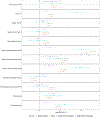The impact of assortative mating, participation bias and socioeconomic status on the polygenic risk of behavioural and psychiatric traits
- PMID: 38366106
- PMCID: PMC11161911
- DOI: 10.1038/s41562-024-01828-5
The impact of assortative mating, participation bias and socioeconomic status on the polygenic risk of behavioural and psychiatric traits
Abstract
To investigate assortative mating (AM), participation bias and socioeconomic status (SES) with respect to the genetics of behavioural and psychiatric traits, we estimated AM signatures using gametic phase disequilibrium and within-spouses and within-siblings polygenic risk score correlation analyses, also performing a SES conditional analysis. The cross-method meta-analysis identified AM genetic signatures for multiple alcohol-related phenotypes, bipolar disorder, major depressive disorder, schizophrenia and Tourette syndrome. Here, after SES conditioning, we observed changes in the AM genetic signatures for maximum habitual alcohol intake, frequency of drinking alcohol and Tourette syndrome. We also observed significant gametic phase disequilibrium differences between UK Biobank mental health questionnaire responders versus non-responders for major depressive disorder and alcohol use disorder. These results highlight the impact of AM, participation bias and SES on the polygenic risk of behavioural and psychiatric traits, particularly in alcohol-related traits.
© 2024. The Author(s), under exclusive licence to Springer Nature Limited.
Conflict of interest statement
Competing Interests
Dr. Polimanti is paid for their editorial work on the journal Complex Psychiatry and reports a research grant from Alkermes. The other authors declare no competing interests.
Figures



Similar articles
-
Association between genetic liability to physical health conditions and comorbidities in individuals with severe mental illness: an analysis of two cross-sectional observational studies in the UK.Lancet Psychiatry. 2025 Jun;12(6):447-456. doi: 10.1016/S2215-0366(25)00123-3. Epub 2025 May 5. Lancet Psychiatry. 2025. PMID: 40339590
-
Protein Associations With Alcohol Consumption and Genetic Risk for Alcohol-Related Sociomedical Conditions.Addict Biol. 2025 Jun;30(6):e70045. doi: 10.1111/adb.70045. Addict Biol. 2025. PMID: 40556615 Free PMC article.
-
Bias and Precision of Parameter Estimates from Models Using Polygenic Scores to Estimate Environmental and Genetic Parental Influences.Behav Genet. 2021 May;51(3):279-288. doi: 10.1007/s10519-020-10033-9. Epub 2020 Dec 10. Behav Genet. 2021. PMID: 33301082 Free PMC article.
-
Socioeconomic status and non-communicable disease behavioural risk factors in low-income and lower-middle-income countries: a systematic review.Lancet Glob Health. 2017 Mar;5(3):e277-e289. doi: 10.1016/S2214-109X(17)30058-X. Lancet Glob Health. 2017. PMID: 28193397 Free PMC article.
-
In-work tax credits for families and their impact on health status in adults.Cochrane Database Syst Rev. 2013 Aug 6;2013(8):CD009963. doi: 10.1002/14651858.CD009963.pub2. Cochrane Database Syst Rev. 2013. PMID: 23921458 Free PMC article.
Cited by
-
Highly parameterized polygenic scores tend to overfit to population stratification via random effects.bioRxiv [Preprint]. 2024 Jan 29:2024.01.27.577589. doi: 10.1101/2024.01.27.577589. bioRxiv. 2024. PMID: 38352303 Free PMC article. Preprint.
-
Mechanisms creating homogamy in depressiveness in couples: A longitudinal study from Czechia.Sci Rep. 2025 Mar 17;15(1):9143. doi: 10.1038/s41598-025-93065-7. Sci Rep. 2025. PMID: 40097516 Free PMC article.
-
Genetic basis of partner choice.bioRxiv [Preprint]. 2025 Feb 5:2025.02.03.636375. doi: 10.1101/2025.02.03.636375. bioRxiv. 2025. PMID: 39975039 Free PMC article. Preprint.
-
Examining the role of common variants in rare neurodevelopmental conditions.Nature. 2024 Dec;636(8042):404-411. doi: 10.1038/s41586-024-08217-y. Epub 2024 Nov 20. Nature. 2024. PMID: 39567701 Free PMC article.
-
Sex differences in the confounders influencing the relationships linking socioeconomic factors and cognitive performance with family history of Alzheimer's disease and related dementias.Alzheimers Dement. 2025 May;21(5):e70215. doi: 10.1002/alz.70215. Alzheimers Dement. 2025. PMID: 40421744 Free PMC article.
References
Publication types
MeSH terms
Grants and funding
LinkOut - more resources
Full Text Sources

